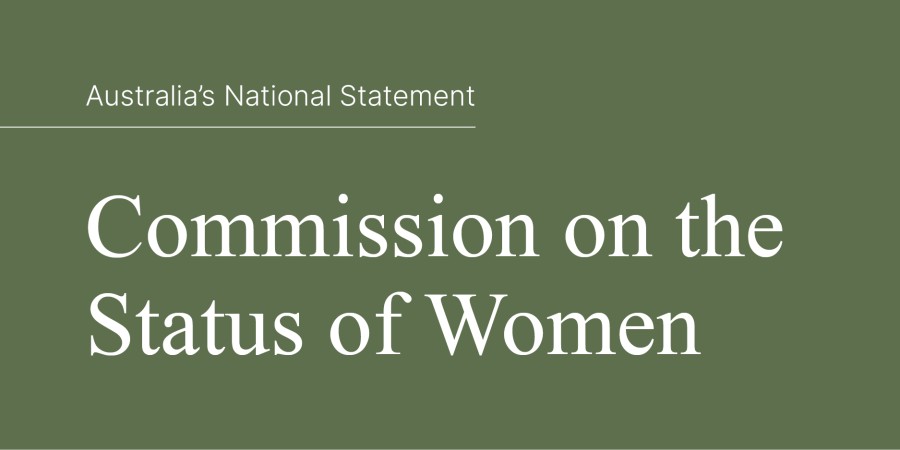
The 69th Session of the Commission on the Status of Women (CSW69) was held at the United Nations Headquarters in New York City from 10 to 21 March 2025.
Over the two weeks, the importance of global cooperation and continuing efforts in support of gender equality shone through in many discussions and presentations.
Australia’s national statement was delivered by Padma Raman PSM, Executive Director of the Office for Women. The statement highlighted Australia’s longstanding architecture for supporting gender equality – including the Office for Women, the presence of the Sex Discrimination Act, and the Office of the Sex Discrimination Commissioner. It also acknowledged Australia’s record investments to end gender-based violence, and the power of recent reforms including positioning gender equality as a central objective of all policy decisions, making childcare more accessible, and the expansion of Australia’s Paid Parental Leave scheme.
Watch Padma Raman's delivery of Australia’s national statement to the 69th Session of the Commission on the Status of Women.
CSW69 National Statement – as delivered (14 March 2025)
I would like to begin by acknowledging the traditional lands of the Lenape people.
As Executive Director of Australia’s Office for Women, I am honoured to be here representing the women of Australia on behalf of our Minister for Women.
Last year we celebrated the 50th anniversary of the Office for Women – for half a century, the Office has made important contributions and progress to the standing of women and girls in all their diversity both domestically…and internationally.
But, even after 50 years, we still have so much more to do.
Australia has a strong and enduring commitment to the Commission on the Status of Women and our shared goal of achieving gender equality..
In 1983 Australia ratified CEDAW.
And in 1984 Australia’s Sex Discrimination Act became law, prohibiting the unfair treatment of persons based on sex, sexual orientation, and gender identity.
It made sexual harassment illegal and established the Office of the Sex Discrimination Commissioner.
Building on this progress, Australia has continued to close workplace gender gaps, from our first women’s affirmative action law in 1986 to now where we have made gender equality a central objective of our Fair Work Act – an Act governing workplace relations, pay and conditions.
We are on a pathway to expand Australia’s Paid Parental Leave Scheme to six months in 2026 and have included ‘reserved’ leave provisions to encourage more men to take it. We are also making major investments for universal childcare.
2025 is Australia’s Workplace Gender Equality Agency’s second year of publishing the gender pay gaps of private sector employers with more than 100 employees – because transparency drives action and accountability.
In Australia, women's participation in paid work is increasing - from 52.9% 30 years ago, to an all-time high of 63.5%.
At the same time, our gender pay gap is decreasing, currently at 11.9%, down from 18.6% 10 years ago.
Australia’s first national gender equality strategy, Working for Women, was launched last year. It provides a 10-year plan to build an Australia where people are safe, treated with respect, have choices, and have access to resources and equal outcomes no matter their gender.
We have placed gender equality at the centre of public policy and our Budget, including through gender responsive budgeting...
And are making record investments to end gender-based violence in Australia in one generation.
As we reflect here at CSW69, on the 30th anniversary of the adoption of the Beijing Declaration and Platform for Action, we are acutely aware more needs to be done.
We must come together globally with renewed determination to advance and secure all women’s and girls’ human rights. And to protect the gains already made at home and around the world.
Australia’s recently launched International Gender Equality Strategy reaffirms the centrality of gender equality to our global engagement…understanding it is a necessary foundation for peace, prosperity and stability.
Reducing sexual and gender-based violence, including in relation to armed conflict, is one of the four outcomes of Australia’s 2021-2031 National Action Plan on Women, Peace and Security.
Achieving gender equality and protecting women’s rights demands consistent and vigilant action.
Now is the time to strengthen our determination.
We need to continue to advance the rights of all women and girls.
These rights have been so fiercely advocated for, so strongly fought for, and agreed upon internationally – we must not let our efforts backslide.
The Australian government’s enduring and enhanced commitment to achieving gender equality is vital to ensuring the progress we’ve made is not only preserved, but expanded upon.
Thank you.
